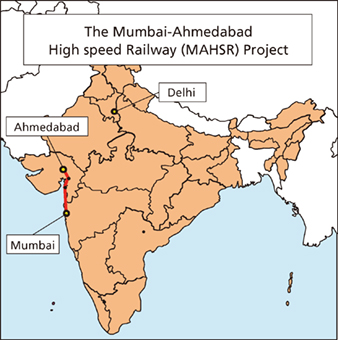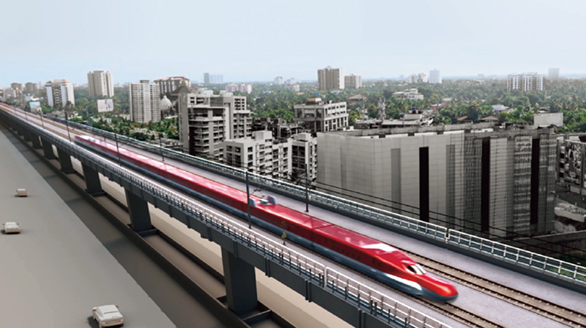ODA Topics 1
Japan's World-class Shinkansen Bullet Train Runs through the Vast Land of India

The Mumbai-Ahmedabad High Speed Railway (MAHSR) Project, which will connect India's largest city of Mumbai with Ahmedabad, a prosperous commercial and financial center, is India's first project to construct a high speed railway system. With the introduction of Japan's bullet train system in combination with ODA assistance from Japan, MAHSR has become a flagship project representing the “new era in Japan-India relations.”
Since India announced its vision of high-speed railway in 2009, Japan's public and private sectors have put great effort into realizing the adoption by India of Shinkansen. Japan and India agreed to conduct a joint feasibility study at the Japan-India Summit Meeting held in Tokyo in May 2013. Memorandum of Cooperation between the Government of Japan and the Government of the Republic of India on High Speed Railways was subsequently signed at the Japan-India Summit Meeting held in Delhi in December 2015, which decided the introduction of the Shinkansen system.
As one of the fruits of these efforts, an Exchange of Notes for an ODA loan of ¥100 billion was signed for the first time in this project in the presence of the Prime Ministers of both countries during the visit of Prime Minister Abe to India in September 2017. A magnificent groundbreaking ceremony for the project was also held nearby Sabarmati Station in Ahmedabad, which will be the final stop on the new line. The ceremony marked the first step for this major historic project witnessed by nearly 10,000 people including both Prime Ministers and relevant ministers from India, railway circles, and members of Japanese companies.

Illustration of the Mumbai-Ahmedabad High Speed Railway (MAHSR) (Photo: National High Speed Rail Corporation Limited (NHSRCL))
When the MAHSR is completed, the new high-speed train based on the E5 model used in Japan will travel the approximately 500 kilometer distance from Mumbai to Ahmedabad (roughly the same distance as Tokyo to Osaka) at speeds up to 320 km/h. According to the Japan-India joint feasibility study, the new high-speed train will be able to travel that distance in two hours, compared with the seven hours required by the current express train service or approximately one and half hours by air, and the cost is estimated to be roughly half of the airfare. There has not been a single death to a boarded passenger from a rail accident over the 50 years of Shinkansen operation in Japan, and the system offers various technological advantages. The Government of Japan is also providing support to the Government of India in the area of human resource development for the future management of the high speed rail system, including providing ODA loans for the construction of the training institute for the high speed rail and technical cooperation that includes the training in Japan of personnel from the National High Speed Rail Corporation Limited and the Ministry of Railways. The adoption of the Shinkansen system is expected to raise the overall level of railway technology and personnel in India. The economic and social benefits of the subsequent development of the railway networks and development around train stations is also expected to contribute to further economic development, job creation, and the resulting poverty reduction in India.
Furthermore, in a Japan-India Joint Statement issued in 2017, the Prime Ministers of both countries expressed their strong commitment to work together to enhance connectivity in India and with other countries in the Indo-Pacific region. Under the “Free and Open Indo-Pacific Strategy,” Japan will continue to cooperate with India's “Act East policy,”* and proactively contribute to the economic prosperity of the region including India through such projects as this high-speed rail project under the Japan-India Special Strategic and Global Partnership.
- * A policy of Prime Minister Modi emphasizing relations with East and Southeast Asia to strengthen relationships with countries in South Asia and ASEAN countries through increased exchange between Prime Ministers.
